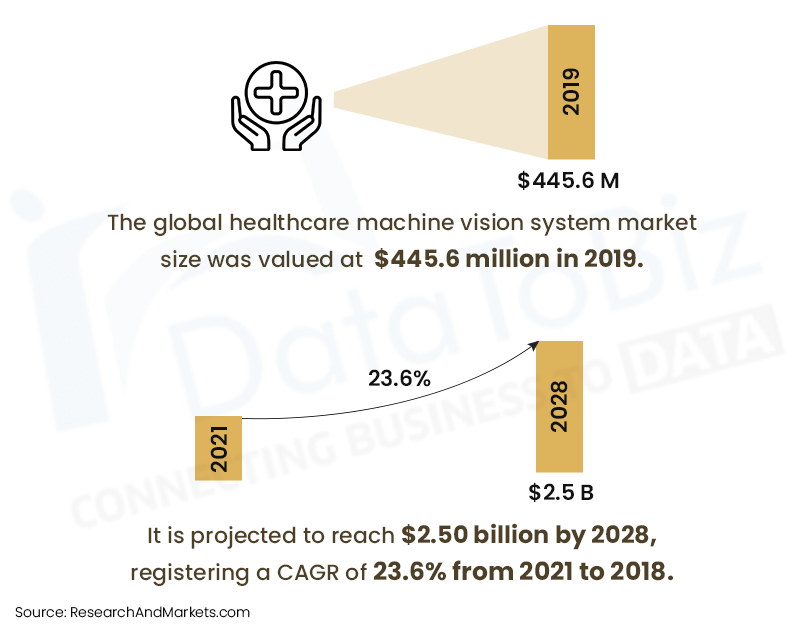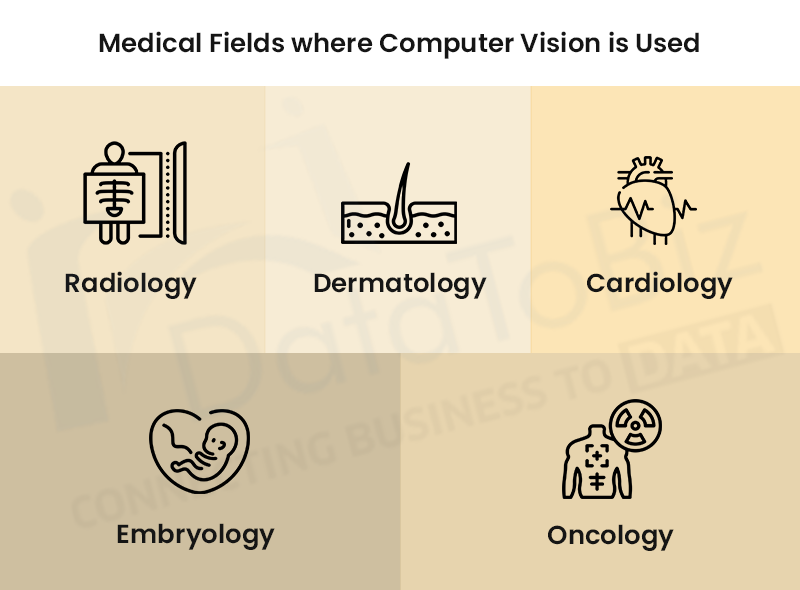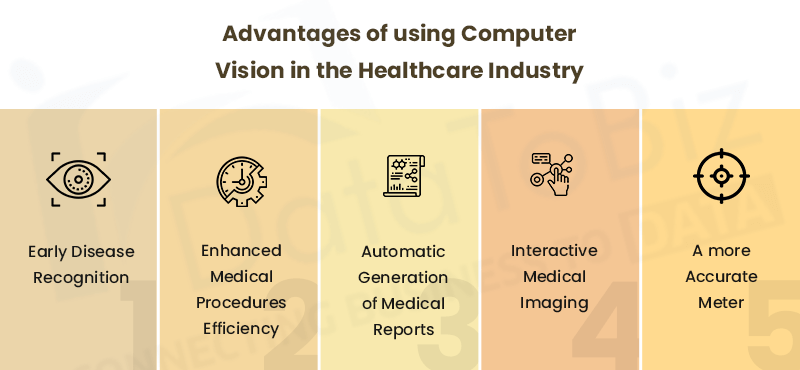Computer vision identifies patterns in data using artificial neural networks. It helps doctors accurately diagnose complex health conditions and provide effective treatment to patients. Computer vision improves the quality of medical services.
Science and technology are a part of our lives. But there’s one area that relies exclusively on them, and that’s the medical industry. Be it for research or healthcare, the medical industry is dependent on science and technology. The computer vision in the healthcare market in 2019 was valued at $445.6 million. It is expected to have a CAGR of 23.6% and touch $2.50 billion by 2028.
Over the years, we have seen how new equipment and advanced tools are helping doctors and scientists to diagnose diseases accurately and provide better treatment. Artificial intelligence has begun to make a lot of difference in the medical and healthcare industry. From using robotic arms to perform surgeries to relying on computer vision for medical imaging, AI is enhancing the quality of healthcare services offered to the public.
Artificial intelligence is an umbrella term that has various subfields interconnected with each other. If machine learning is one, computer vision is another. Artificial neural networks, natural language processing, and deep learning are other areas of AI used in various industries, either independently or in sync with different subfields.

We have mentioned computer vision as a part of AI. But what exactly is computer vision, and how does it help the medical industry?
Computer vision has been designed to empower computers to recognize and understand images so that actions that are usually performed by humans are now done by computers. It is the process of automating tasks that were previously handled by humans.
A computer vision consulting firm works on training and enabling computers to replicate human sight and understanding processes the way humans do. It is much more than simply copying human actions without understanding the reasons for it.
Computer vision is already being used by platforms like Facebook and Amazon to provide personalized services. The technology is making progress in the medical industry to assist doctors and healthcare personnel in identifying patterns, detecting anomalies, and making accurate diagnoses to provide correct treatment to the patients.
Do you know that it took less than a decade for computer vision technology to be 99% accurate from being just 50% accurate back then? Computer vision was first used in the 1950s to distinguish between typed and handwritten text. Today, technology can process and analyze images to understand which action has to be performed.
One of the primary reasons for the growth of computer vision is the increase in data. With billions of images being shared online every day, it has become necessary to use technology like computer vision to process these images and identify the objects/ data in them.
In a way, the process is similar to recognizing and tracing patterns. We could say that computer vision relies on neural networks and algorithms that mimic human minds to observe images the way humans do. Facial recognition is one example of computer vision.
Earlier, creating something like this needed a lot of manual work. And yet, the margin of error was high. But with machine learning algorithms and deep learning becoming more precise, the need for human intervention has reduced.
However, if you want to invest in computer vision technology, you will need to hire CV experts to handle the systems. Many organizations, including the medical industry, are hiring computer vision services to enhance their processes and deliver high-quality services.
The medical industry is made up of several subfields, each of which focuses on different specializations. For example, dermatology deals with skin, cardiology is about the heart, and so on. Computer vision is used in each field in a different way to assist doctors to detect early signs of symptoms and prevent the disease from affecting the patient after they have recovered from it.
Computer vision assists physicians to make the correct diagnosis, especially if he hasn’t come across a case like that before. The job of a radiologist is to-
Computer vision applications help dermatologists in three ways-
Computer vision applications and virtual reality hardware are used together by cardiologists so that they can-
Computer vision is transforming IVF (In Vitro Fertilization) through-

Computer vision is now accurate enough (more than 99%) and is known to predict and measure data by analyzing images with great clarity. Gauss Surgical has developed a computer vision application that helps measure blood loss during childbirth. Excessive bleeding during childbirth has caused a lot of complications and the death of new mothers for centuries.
This application helps measure the amount of blood loss so that the doctors will know when things will get risky for the patient. The CV tool uses studies of images of surgical sponges and suction canisters used during the delivery to determine if the patient is at the risk of suffering from excessive blood loss.
False positives can prove to be costly, not only in terms of money but also in terms of life. Treating someone for a disease they don’t have but have been tested positive because of faulty analysis can lead to short-term and long-term ill-effects.
AI Vision Consultancy services help healthcare centers develop computer vision tools that can process a vast amount of data and identify subtle changes in patterns. There are two advantages of using CV applications for testing patients.
One is the reduction in the number of false positives, and another is the detection of minute symptoms that could, in all probability, be missed when using traditional testing methods. Instead of going through multiple tests to confirm whether they are really positive for a disease, a patient can rely on the reports generated using CV tools.
Patients suffering from cancer, Alzheimer’s, Parkinson’s, etc., have more chances of leading better lives if their illness could be detected in the earlier stages. Traditional tests and examinations do not detect early signs of all diseases the way a computer vision tool can.
Though doctors use their experience and intuition to guess the symptoms, if tests do not show up the results, there is little they can do. Computer vision plays a crucial role here. The algorithms can identify the pattern and alert doctors that the patient indeed has slight symptoms of a particular illness.
Neurological illnesses can be detected using AI tools and computer vision tools. Hospitals now use machine vision consulting services to analyze CT scans to understand if the images show signs of neural illness.
Any slight change in the pattern will be detected and highlighted by the CV tool. Using computer vision makes diagnosis faster and precise. The applications can process thousands of images and analyze the patterns in less time. What would take a lab technician days can be done in just minutes or a couple of hours by CV tools.
Skin cancer is one of the toughest diseases to diagnose. There are such minute differences in the appearance of skin cancer cells that traditional methods do not deliver highly accurate results.
Scientists from Stanford University AI Lab have created a model that can identify and classify cancerous skin cells and assist doctors in detecting the disease in its early stages. The team has used deep convolutional neural networks (CNNs) to create the model with more than 120,000 sets of images of skin cancer cells.
CNN is a class of deep neural networks (in deep learning) used to analyze images, classify them, and automatically correlate data in the systems.
Wouldn’t it be great if radiologists can create 3D models of a patient’s heart to identify anomalies that could lead to life-threatening conditions? Computer vision makes it possible to do just that. It reduces the time required to scan the patients while increasing the chances of identifying even the slight anomalies by magnifying the selected areas on the computer screen. Artersy’s CardioAI is one such software that uses 4D flow to let radiologists study the 3D images of a patient’s heart on the computer screen. The technician can manipulate the images to check if the heart is functioning the way it should or if the patient is suffering from undetected heart ailments.
Medical imaging has become a part of several healthcare facilities during the last decade. Computer vision helps create 3D images of 2D pictures and scans. The CV tool can read the images and analyze them to highlight symptoms and signs of disease. This gives the doctors a better understanding of the patient’s health condition. When the doctor knows the exact medical condition of a patient, it becomes easier to create a treatment chart and prescribe the correct medication.
Computer vision is frequently used to monitor the health condition of patients, especially the ones who are recovering from surgery or treatment. Patients at home and in the hospital can be monitored using CV tools. Computer vision applications alert healthcare personnel about any sudden changes in the condition of a patient.
Imagine a patient in the recovery ward suffering from a sudden blood loss or reaction to a medicine. CV tools can detect the signs in the early stages and alert the doctors to take any action before the patient’s life is in danger.
Nuclear medicine is a section of clinical medicine that uses radioactive substances to diagnose and treat certain medical conditions. Radiation therapy like chemotherapy is an example. Cancer, hyperthyroidism, lymphomas, etc., are treated using radiopharmaceuticals and computer vision techniques. Computer vision helps in determining and optimizing the amount of radioactivity required for each patient. Imaging is used to assess and monitor the changes in high-risk patients.
Computer vision consultants develop CV tools to assist with surgical simulation and surgeries. These tools help doctors make crucial decisions when performing complex surgeries. We know how a wrong decision could lead to the death of the patient. The aim of using CV applications is to reduce the death rate and increase the success rate of surgeries. CV helps surgeons use augmented reality in real-time during surgery.
One example of this is the mobile app called Touch Surgery that allows anyone who downloads and uses the app to learn how to perform surgeries. The app is a great help for medical students and trainees to improve their skills.
Clinical trials are an inherent part of the medical industry. Researchers and scientists spend weeks and months conducting the trials and making observations about how the medicine is working. Computer vision apps can be used on mobile phones to monitor the people who are being tested. The algorithm is such that it can compare the health conditions and changes of the patients to the past data and analyze whether the medication is providing the expected results or not.
The pictures of the patients taking the medicine or the CCTV footage of the patients’ movements are compiled and processed using computer vision to study how the patients are responding to the medicines. For example, AiCure developed software that helps researchers track how the patients are responding to medicines. The patients are asked to download the app and take their medicines by opening the app and facing the camera.

Computer vision can work miracles in the medical industry by improving the quality of healthcare services provided to patients. From detecting early signs of disease to monitoring the patient’s condition during and after surgery, CV can be used in various ways.
Contact computer vision consulting service providers to know more about how CV tools can be integrated into the existing systems of the healthcare center. You can either choose from the existing CV applications or ask the consulting companies to create a model based on your specific requirements.
You must be logged in to post a comment.

Nice Blog